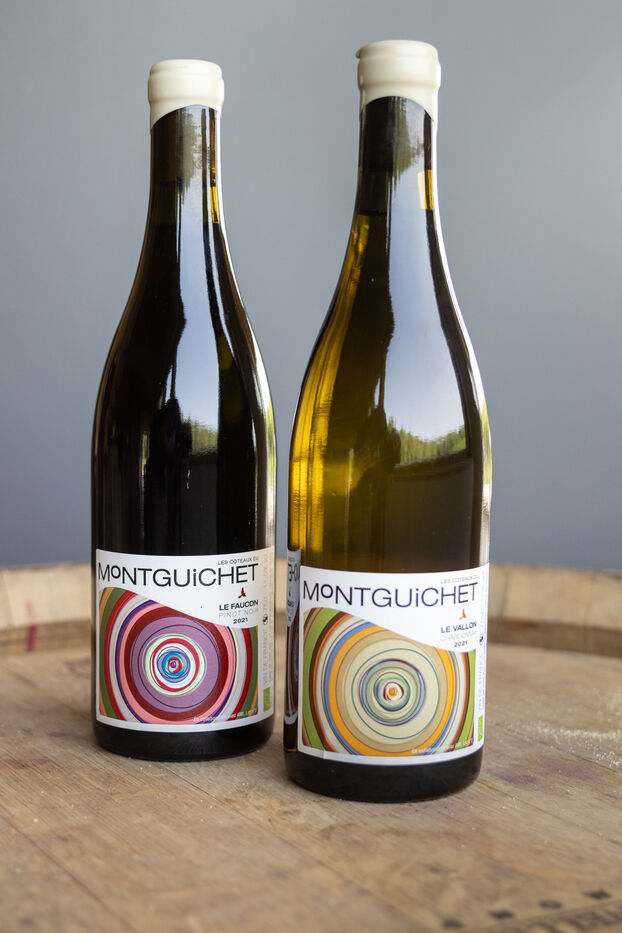Listen to the good news ! The rebirth of an appellation once famous among the Kings of France, near Paris, twice as big as Burgundy !

“Le Faucon” Organic 2021, a Pinot Noir, and “Le Vallon” Organic 2021, a Chardonnay.
Winner of the second edition of the Concours des Vins d’Île-de-France 2023, the two Cuvées were elected Best White and Best Red.
The story behind
The Domaine, created in 2018 and planted in 2019, is located in Chelles, Seine-et-Marne, 25 km from Paris. It has 6 ha of vines, 2 ha of Pinot Noir, 2 ha of Chardonnay, 1 ha of Pinot Gris, 1 ha of Savagnin, a grape variety from the Jura.
Pierric doesn’t come from nowhere. Carpenter for 25 years, passionate about the vineyard and wine, he is not a beginner in the world of Bacchus. Trained in viticulture and œnology in Burgundy, he spent a few years in the countries of Chassagne-Montrachet before making the choice to plant his 6 hectares (soon 7 ha) of organic vines in Île-de-France.

An old Tradition
Hard to imagine that in the Middle Ages, the Seine-Saint-Denis was covered with famous hillsides! The Ile-de-France abbeys did not have to blush for their excellent white wines, drawing the whole region into viticulture over the centuries. “At the end of the 18th century, 52,000 hectares of vines were planted in Île-de-France, twice the size of Burgundy!” says Pierric Petit.
With time and the multiplication of the vines, the quality of the wine has deteriorated.
« Everyone was producing his own wine and it wasn’t necessarily great wines », he notes. The wine culture in Île-de-France finally died out with the arrival of the railway combined with the phylloxera epidemic as we mentioned in our first article.
Nearly two centuries later, Pierric Petit launched his first two cuvées. He is looking for fine, delicate wines, not too powerful; original, authentic, organic of course, truly representative of the place, the Terroir, distributed in short circuits.
“One of the vocations of the Estate is also the transmission, sharing, conviviality, pleasure.” 1000 bottles in 2021, the vines having almost completely frozen, 15,000 bottles produced in 2022, 22,000 expected in 2023, distributed by the wine merchants of Île-de-France.
The entry-level should be around 15 euros. “It’s a cost but my goal is to share the love of wine, not to be distributed everywhere at low prices. The idea is to be able to interact with customers directly or through other enthusiasts such as wine merchants.”

Create social connection and pride
Pierric Petit’s eyes become sparkling when he talks about connecting the city to its inhabitants through the passion for wine. « We are here on a terroir both historically wine-growing and peri-urban, it’s unique !», rejoices the winemaker from his pretty tasting room all of light wood and waxed concrete.
The frames are freshly finished by him (being a carpenter has its advantages). “In this room, I hope to be able to develop pedagogy around wine, with the inhabitants of the region, businesses. But it will not only be used for trainings: we have already started to organize aperitifs with the inhabitants of Chelles. I would like to set up concerts, parties, exchanges. I am convinced that vines planted in a peri-urban area create a social bond and give a certain pride to a territory.”
Build a place of conviviality on the culture of wine
Behind this idea also exists a social objective: agriculture makes it possible to develop employment and training. Because here, there is no question of over-mechanizing the harvest for those who define themselves as an “artisan winemaker”: « Doing everything or almost by hand, creates jobs, but also significantly improves the quality of the wine. »
Natural solutions to maintain and fertilize soils, fight pests and heat waves
Tenant of the regional council of Île-de-France, Pierric Petit intends to contribute to the building of Greater Paris by setting a long-term activity on these former wastelands. “This is an 18-year rural lease. It already takes a minimum of 3 to 4 years to get a first batch. You have to take your time to make wine! And it didn’t work in my favour against the bankers when I wanted to borrow money to settle in, but that’s another story,” recalls the winemaker between two rows of vines that are now higher than him.
Sensitive to the great biodiversity of the site, man is one of those farmers who like to experiment with natural solutions, such as planting other species in the middle of the hills (“viti-forestry”) to try to overcome the heatwaves to come with shadows, or to fight parasites.
“The more biodiversity there is, the less a parasite can develop. But we have to try, make mistakes, start over. Not all plants succeed,” he explains, carried away by his subject.
The eco-grazing, practiced with about fifty sheep, allows the maintenance without any chemicals and the natural contribution of fertilizer.
At the corner of a vineyard, we meet a smiling young man with a pruner, the son of Pierric Petit. The passion for wine seems to have taken well in the family.
To be followed! (Dr. FX)
Benchmark
The IGP (protected geographical indication) “Île-de-France”, may be supplemented by the name of one or more grape varieties (…), by the words “primeur” or “nouveau”, “sur lie” (or) by the names of the following smaller geographical units (…): Coteaux de Suresnes-Mont-Valérien, Coteaux de Blunay, Coteaux d’Acy, Coteaux de Provins or Paris.”
But the most original lies in the grape varieties allowed: there are 37 white, 3 grey, 30 black and 5 rosé varieties; 75 varieties in total ! Among these are green Aubin, Chasan, Gringet, Précoce de Malingre, Rayon d’or for whites, or Egiodola, Joubertin, Noir Fleurien or Villard noir for red varieties.
Practical information:
Domaine des coteaux du Montguichet, 5, chemin du Beauzet, Chelles (77500). Access: Chelles–Gournay station (RER E) and 2 km walk. More info on Facebook.

